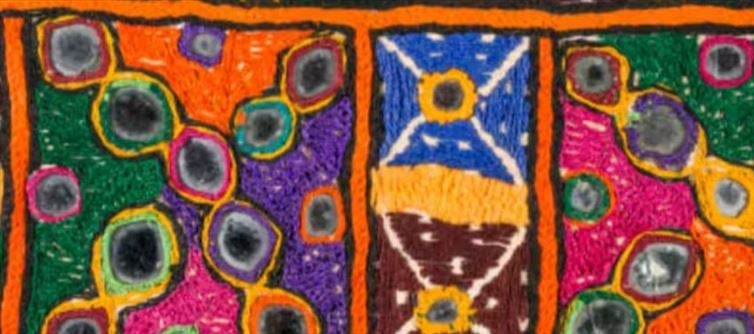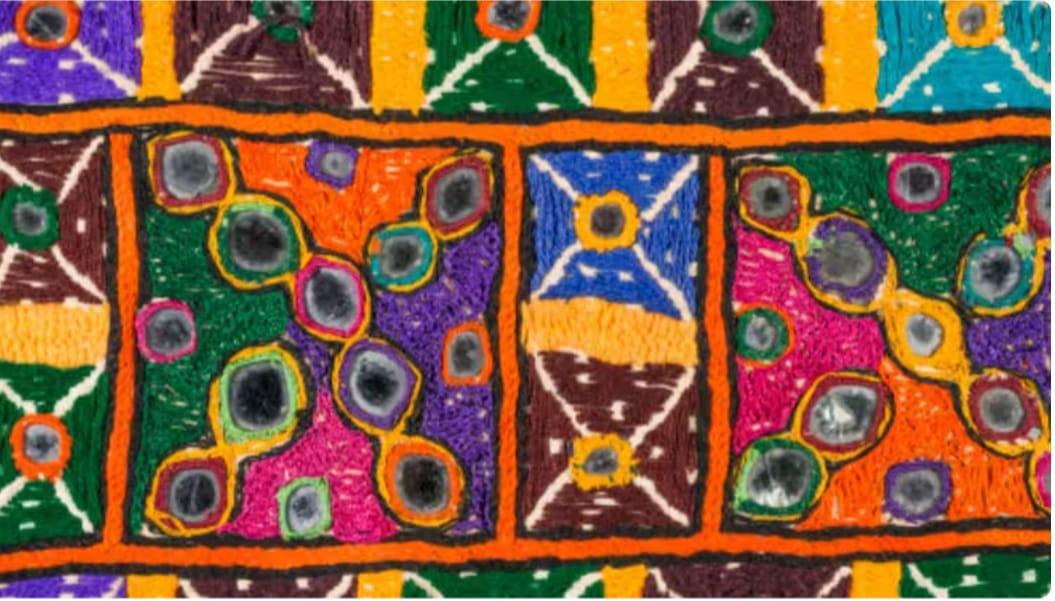
What Is Sheesha's Work? Know Things To Keep In Mind Before Buying This Embroidery
The craft involves the use of small pieces of mirrors, usually circular, which are embroidered into the fabric using colorful threads, creating stunning and vibrant designs.

Sheesha or mirror work as it is called are beautiful embellishments made on sarees & lehengas. The difference between the original sheesha work and their look-alike made with foil is sometimes not visible unless checked carefully. The word "sheesha" itself is derived from the Persian word for glass. The craft involves the use of small pieces of mirrors, usually circular, which are embroidered into the fabric using colorful threads, creating stunning and vibrant designs.
History And Origin Of Sheesha's Work:
Sheesha's work has a rich history dating back to ancient India, where it was originally used to embellish royal garments and textiles. Rishab Jain, who is the Brand head of Rishab World Pvt. Ltd. said, "The mirror work, which dates back to 500 BCE, has become an integral part of our culture, civilization, and Vedic scriptures. It has found a place in our folk art, handicrafts, and our daily lives. It spreads positivity and brings shine to our personality."
"Sheesha's work is believed to have originated in the indian subcontinent, particularly in the regions of gujarat and Rajasthan. These areas have a rich tradition of textile arts and embroidery, and sheesha work is believed to have evolved as part of this tradition," he added.
In addition, Rishab Manocha, who is the Associate professor of fashion Design, at Pearl Academy said, "Today, sheesha work is celebrated worldwide for its exquisite craftsmanship and cultural significance. These sarees are known for their intricate design and craftsmanship."
How Is Sheesha's Work Done?
Rishab Jain explained how Sheesha's work is done saying that in the traditional art of tie and dye, cloth is tied and knotted before being dyed.
He said, "The cloth is tightly bound with threads before being immersed in a dye bath and when the threads are untied, the bound part becomes colorful. Then, this tie and dye cloth is crafted using colorful threads. Later, each mirror is meticulously placed on the fabric using colorful silk threads."
Historically, sheesha work was primarily done on traditional garments such as sarees, dupattas (scarves), and other traditional attire worn by women in India. It was often associated with festive occasions and special events, where the shimmering mirrors added an extra element of glamour to the clothing," he added.
Popular Designs and Patterns in Sheesha Work on Sarees:
Prof. Rishab Manocha shared a few popular designs and patterns that are done using sheesha work:
Peacock Motifs – Peacock-inspired patterns with mirror embellishments are a timeless favorite in Sheesha's work on sarees.
Floral Elegance - Intricately stitched floral designs adorned with mirrors add a touch of elegance and grace to the saree.
Geometric Symmetry - Modern sarees feature geometric patterns incorporating mirrors, creating a contemporary yet classic look.
Techniques and Materials Used in Sheesha Work:
Talking about techniques and materials, Prof. Rishab Manocha said:
Artistic Precision- Sheesha's work involves meticulous hand-stitching of mirrors using fine, colored threads to create striking patterns.
Quality Fabrics - Cotton, silk, and chiffon are commonly chosen for their ability to showcase the mirrors and provide a beautiful drape.
Decorative Embellishments - Intricate beadwork and vibrant thread colors are also used to complement the mirror placements, adding depth and texture to the design.
Traditional and Contemporary Styles of Sheesha Work:
He also discussed the kind of designs done for traditional and contemporary styles of sheesh work and mentioned the following:
Traditional Elegance Time - Honoured designs with classic mirror placements that reflect the cultural heritage.
Modern Interpretations - Contemporary adaptations incorporate innovative mirror techniques, offering a fusion of tradition and trend.
Versatile Appeal - Sheesha's work is now embraced in a range of styles, from bold and vibrant to understated and minimalistic silhouettes.
Things To Keep In Mind Before Buying Sheesha Work:
Sonam Bhagat, who is the founder of VYGR suggested the following things to keep in mind to distinguish an original sheesha embroidery from a fake one:
Look for small, flat different mirrors stitched onto the fabric.
They should catch the light and gleam when you move.
Sheesha's work often incorporates intricate embroidery patterns around the mirrors. These patterns can be floral, geometric, or other motifs.
Sheesha's work can be done with mirrors of different colors, creating a mosaic effect. The fabric itself might also have a different texture due to the embroidery and mirror attachments.
Run your fingers over the fabric. Sheesha's work should feel a slightly raised texture due to the presence of the mirrors and embroidery.
The mirrors themselves should be smooth and flat to the touch, not bumpy or cracked.




 click and follow Indiaherald WhatsApp channel
click and follow Indiaherald WhatsApp channel